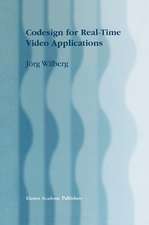Integrating Functional and Temporal Domains in Logic Design: The False Path Problem and Its Implications: The Springer International Series in Engineering and Computer Science, cartea 139
Autor Patrick C. McGeer, Robert K. Braytonen Limba Engleză Hardback – 31 mai 1991
| Toate formatele și edițiile | Preț | Express |
|---|---|---|
| Paperback (1) | 642.65 lei 6-8 săpt. | |
| Springer Us – 30 sep 2012 | 642.65 lei 6-8 săpt. | |
| Hardback (1) | 649.09 lei 6-8 săpt. | |
| Springer Us – 31 mai 1991 | 649.09 lei 6-8 săpt. |
Din seria The Springer International Series in Engineering and Computer Science
- 24%
 Preț: 1041.98 lei
Preț: 1041.98 lei - 20%
 Preț: 643.50 lei
Preț: 643.50 lei - 18%
 Preț: 1225.62 lei
Preț: 1225.62 lei - 18%
 Preț: 965.02 lei
Preț: 965.02 lei - 20%
 Preț: 646.12 lei
Preț: 646.12 lei - 18%
 Preț: 948.79 lei
Preț: 948.79 lei - 20%
 Preț: 646.62 lei
Preț: 646.62 lei - 15%
 Preț: 637.46 lei
Preț: 637.46 lei - 20%
 Preț: 643.83 lei
Preț: 643.83 lei - 18%
 Preț: 949.23 lei
Preț: 949.23 lei - 20%
 Preț: 644.48 lei
Preț: 644.48 lei - 20%
 Preț: 994.92 lei
Preț: 994.92 lei - 20%
 Preț: 645.97 lei
Preț: 645.97 lei - 18%
 Preț: 946.87 lei
Preț: 946.87 lei - 20%
 Preț: 995.57 lei
Preț: 995.57 lei - 18%
 Preț: 956.99 lei
Preț: 956.99 lei - 20%
 Preț: 644.98 lei
Preț: 644.98 lei - 15%
 Preț: 649.54 lei
Preț: 649.54 lei - 18%
 Preț: 950.21 lei
Preț: 950.21 lei - 18%
 Preț: 1221.38 lei
Preț: 1221.38 lei - 18%
 Preț: 957.62 lei
Preț: 957.62 lei - 15%
 Preț: 643.99 lei
Preț: 643.99 lei - 18%
 Preț: 948.47 lei
Preț: 948.47 lei - 18%
 Preț: 947.35 lei
Preț: 947.35 lei - 20%
 Preț: 1284.65 lei
Preț: 1284.65 lei - 20%
 Preț: 1628.31 lei
Preț: 1628.31 lei - 20%
 Preț: 1285.78 lei
Preț: 1285.78 lei
Preț: 649.09 lei
Preț vechi: 811.37 lei
-20% Nou
Puncte Express: 974
Preț estimativ în valută:
124.22€ • 129.21$ • 102.55£
124.22€ • 129.21$ • 102.55£
Carte tipărită la comandă
Livrare economică 14-28 aprilie
Preluare comenzi: 021 569.72.76
Specificații
ISBN-13: 9780792391630
ISBN-10: 0792391632
Pagini: 212
Ilustrații: XXIII, 212 p.
Dimensiuni: 155 x 235 x 14 mm
Greutate: 0.52 kg
Ediția:1991
Editura: Springer Us
Colecția Springer
Seria The Springer International Series in Engineering and Computer Science
Locul publicării:New York, NY, United States
ISBN-10: 0792391632
Pagini: 212
Ilustrații: XXIII, 212 p.
Dimensiuni: 155 x 235 x 14 mm
Greutate: 0.52 kg
Ediția:1991
Editura: Springer Us
Colecția Springer
Seria The Springer International Series in Engineering and Computer Science
Locul publicării:New York, NY, United States
Public țintă
ResearchCuprins
1 Introduction.- 1.1 Timing Analysis of Circuits.- 1.2 The General False Path Problem.- 1.3 A Note on Notation.- 1.4 Logic Notation.- 1.5 Outline.- 2 The False Path Problem.- 2.1 Introduction.- 2.2 Dynamic Timing Analysis.- 2.3 Viable Paths.- 2.4 Symmetric Networks and Monotonicity.- 2.5 Viability Under Network Transformations.- 2.6 The Viability Function.- 2.7 Summary.- 3 False Path Detection Algorithms.- 3.1 Generic False Path Detection Algorithm.- 3.2 Viability Analysis Procedure.- 3.3 Dynamic Programming Algorithm Example.- 3.4 Finding all the Longest Viable Paths.- 3.5 Recent Work.- 4 System Considerations and Approximations.- 4.1 Approximation Theory and Practice.- 4.2 “Weak” Viability.- 4.3 The Brand-Iyengar Procedure.- 4.4 The Du-Yen-Ghanta Criteria.- 4.5 The Chen-Du Criterion.- 4.6 More Macroexpansion Transformations.- 4.7 Biased Satisfiability Tests.- 4.8 Axes of Approximation.- 4.9 The Lllama Timing Environment.- 4.10 Experimental Results.- 5 Hazard Prevention in Combinational Circuits.- 5.1 Introduction.- 5.2 Hazards.- 5.3 The Boolean n-Space.- 5.4 The SDC Set and Restricted Cubes.- 5.5 Ordering The Inputs.- 6 Timing Analysis in Hazard-Free Networks.- 6.1 Introduction.- 6.2 Robustness of Dynamic Sensitization.- 6.3 The Dynamic Sensitization Function.- 6.4 Algorithms.- 6.5 Conclusion.- A Complexity Results.- A.1 An Introduction to Polynomial Reducibility.- B A Family of Operators.- C Fast Procedures for Computing Dataflow Sets.- C.1 Introduction.- C.2 Terminology.- C.3 The New Approach.- C.4 Computations.- C.4.1 Basic Algorithms.- C.4.2 Transitivity.- C.4.4 Evaluation Algorithms.- C.5 Correctness.- C.6 Complexity Analysis.- C.7 Efficiency.- C.8 Sparse Matrix Implementation.- C.9 An Improvement.- C.10 Results.- C.11 Extensions.- C.11.1 Extending ArbitraryCubes.- C.11.2 The Fanout Care Set and the Test Function.- D Precharged, Unate Circuits.
























